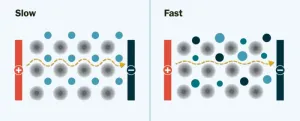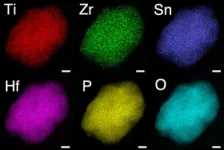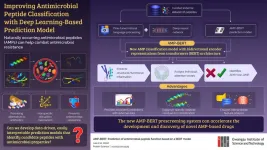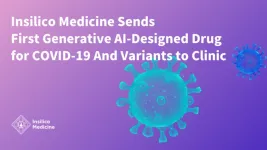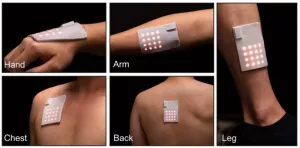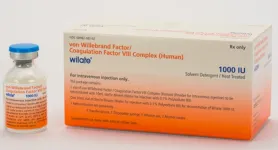(Press-News.org) A team from Lawrence Berkeley National Laboratory (Berkeley Lab) and Florida State University has designed a new blueprint for solid-state batteries that are less dependent on specific chemical elements, particularly critical metals that are challenging to source due to supply chain issues. Their work, reported recently in the journal Science, could advance solid-state batteries that are efficient and affordable.
Touted for their high energy density and superior safety, solid-state batteries could be a game-changer for the electric car industry. But developing one that is affordable and also conductive enough to power a car for hundreds of miles on a single charge has long been a challenging hurdle to overcome.
“With our new approach to solid-state batteries, you don’t have to give up affordability for performance. Our work is the first to solve this problem by designing a solid electrolyte with not just one metal but with a team of affordable metals,” said co-first author Yan Zeng, a staff scientist in Berkeley Lab’s Materials Sciences Division.
In a lithium-ion battery, the electrolyte works like a transfer hub where lithium ions move with electric charge to either power a device or recharge the battery.
Like other batteries, solid-state batteries store energy and then release it to power devices. But rather than liquid or polymer gel electrolytes found in lithium-ion batteries, they use a solid electrolyte.
Government, research, and academia have heavily invested in the research and development of solid-state batteries because the liquid electrolytes designed for many commercial batteries are more prone to overheating, fire, and loss of charge.
However, many of the solid-state batteries constructed thus far are based on specific types of metals that are expensive and not available in large quantities. Some aren’t found at all in the United States.
For the current study, Zeng – along with Bin Ouyang, an assistant professor in chemistry and biochemistry at Florida State University – and senior author Gerbrand Ceder, a Berkeley Lab faculty senior scientist and UC Berkeley professor of materials science and engineering, demonstrated a new type of solid electrolyte consisting of a mix of various metal elements. Zeng and Ouyang first developed the idea for this work while finishing their postdoctoral research at Berkeley Lab and UC Berkeley under the supervision of Ceder.
The new materials could result in a more conductive solid electrolyte that is less dependent on a large quantity of an individual element.
In experiments at Berkeley Lab and UC Berkeley, the researchers demonstrated the new solid electrolyte by synthesizing and testing several lithium-ion and sodium-ion materials with multiple mixed-metals.
They observed that the new multi-metal materials performed better than expected, displaying an ionic conductivity several orders of magnitude faster than the single-metal materials. Ionic conductivity is a measurement of how quickly lithium ions move to conduct electric charge.
The researchers theorize that mixing many different types of metals together creates new pathways – much like the addition of expressways on a congested highway – through which lithium ions can move quickly through the electrolyte. Without these pathways, the movement of lithium ions would be slow and limited when they travel through the electrolyte from one end of the battery to the other, Zeng explained.
To validate candidates for the multi-metal design, the researchers performed advanced theoretical calculations based on a method called density-functional theory on supercomputers at the National Energy Research Scientific Computing Center (NERSC). Using scanning transmission electron microscopes (STEM) at the Molecular Foundry, the researchers confirmed that each electrolyte is made of only one type of material – what scientists call a “single phase” – with unusual distortions giving rise to the new ion transport pathways in its crystal structure.
The discovery enables new opportunities to design next-generation ionic conductors. The next step in this research is to apply the new approach that Zeng has developed with Ceder at Berkeley Lab to further explore and discover novel solid electrolyte materials that can improve battery performance even further.
This work represents one of the many ways in which experts at the Berkeley Lab Energy Storage Center are working to enable the nation’s transition to a clean, affordable, and resilient energy future.
Last year, Ouyang won a NERSC High Performance Computing Achievement Award for “advancing the understanding of chemical short-range order for designing a new generation of commercialized cathode materials.” The award recognizes early-career scientists who have made significant contributions to scientific computation using NERSC resources.
Other scientists contributing to this work are Young-Woon Byeon and Zijian Cai from Berkeley Lab, Jue Liu from Oak Ridge National Laboratory, and Lincoln Miara and Yan Wang from the Samsung Advanced Institute of Technology.
The Molecular Foundry and NERSC are DOE Office of Science user facilities at Berkeley Lab.
This research was supported by the DOE Vehicle Technologies Office.
###
Founded in 1931 on the belief that the biggest scientific challenges are best addressed by teams, Lawrence Berkeley National Laboratory and its scientists have been recognized with 16 Nobel Prizes. Today, Berkeley Lab researchers develop sustainable energy and environmental solutions, create useful new materials, advance the frontiers of computing, and probe the mysteries of life, matter, and the universe. Scientists from around the world rely on the Lab’s facilities for their own discovery science. Berkeley Lab is a multiprogram national laboratory, managed by the University of California for the U.S. Department of Energy’s Office of Science.
DOE’s Office of Science is the single largest supporter of basic research in the physical sciences in the United States, and is working to address some of the most pressing challenges of our time. For more information, please visit energy.gov/science.
END
The National Center to Reframe Aging — the nation’s leading organization dedicated to reshaping the conversation about older people — has established a new advisory board with 16 members from such diverse professional backgrounds as communications and public relations, research, policy, and law.
These board members were tapped to bring knowledge, strategic thinking, and interpersonal attributes to their role; to identify key organizations and decision-makers who can help advance the initiative; and support activities aligning with National Center project goals.
“We look forward to working with this talented group of advisors to grow ...
In 2018, a team of physicists at Purdue University invented a device which experimentally showed quasiparticles interfering for the first time in the fractional quantum Hall effect at filling factor v=1/3. Further development of these heterostructures has allowed the Manfra Group to expand their research to experiments that explore counterflowing charged edge modes at the 2/3 fractional quantum Hall state.
They have recently published their findings, “Half-Integer Conductance Plateau at the ν = 2/3 Fractional Quantum Hall State in a Quantum Point Contact,” in Physical Review Letters on February 17, 2023. This ...
Fungal pathogens that cause die-back in grape, avocado, citrus, nut and other crops has found a new host and is infecting conifer trees causing Pine Ghost Canker in urban forest areas of Southern California.
The canker can be deadly to trees.
Scientists from University of California, Davis, first spotted evidence that the pathogens had moved to pines during a routine examination of trees in Orange County in 2018. Over four years, they found that more than 30 mature pines had been infected in an area of nearly 100 acres, according ...
Over the last few decades, antimicrobial resistance has become a major public health concern globally. This has led to a search for alternative methods of treating microbial infections. One such innovation is the discovery of antimicrobial properties of certain peptides. Antimicrobial peptides (AMPs) are short peptides found in most animals, plants, and microorganisms as a natural defense against infections. AMPs combat harmful bacteria via a nonspecific mechanism that prevents them from developing antimicrobial resistance. Despite these exceptional abilities, research on AMPs is being hindered because the existing systems for identifying candidate ...
The sheer volume of ‘Big Data’ produced today by various sectors is beginning to overwhelm even the extremely efficient computational techniques developed to sift through all that information. But a new computational framework based on random sampling looks set to finally tame Big Data’s ever-growing communication, memory and energy costs into something more manageable.
A paper describing the framework was published in the journal Big Data Mining and Analytics on Jan. 26.
The amount of data being produced from social networks, business transactions, the ‘Internet of Things’, finance, healthcare and beyond has exploded ...
Insilico Medicine, a clinical-stage biotech company powered by generative AI, today announces that China National Medical Products Administration (NMPA) has approved the Investigational New Drug (IND) application for ISM3312, an orally available 3CLpro inhibitor generated and designed with the support of Insilico’s proprietary generative chemistry platform Chemistry42 for the treatment of COVID-19.
ISM3312 is a highly selective small molecule inhibitor with a novel molecular structure optimized from compounds which were generated and designed by Chemistry42 based on the structure of 3CL protease. It binds to ...
As air pollution in Stockholm has decreased, so has the lung capacity of children and adolescents has improved, a new study published in the European Respiratory Journal reports. The researchers from Karolinska Institutet consider the results important, since the lung health of the young greatly affects the risk of their developing chronic lung diseases later in life.
“Fortunately, we’ve seen a decrease in air pollutants and therefore an increase in air quality in Stockholm over the past 20 years,” says the study’s last author ...
Sensing a hug from each other via the internet may be a possibility in the near future. A research team led by City University of Hong Kong (CityU) recently developed a wireless, soft e-skin that can both detect and deliver the sense of touch, and form a touch network allowing one-to-multiuser interaction. It offers great potential for enhancing the immersion of distance touch communication.
“With the rapid development of virtual and augmented reality (VR and AR), our visual and auditory senses are not sufficient for us to create an ...
PARAMUS, N.J. (Feb. 23, 2023) – Octapharma USA has submitted a Biologics License Application Supplement (sBLA) to the U.S. Food and Drug Administration (FDA) to expand the approval of wilate®, von Willebrand Factor/Coagulation Factor VIII Complex (Human) Lyophilized Powder for Solution for Intravenous Injection, to include routine prophylaxis to reduce the frequency of bleeding episodes in children and adults with any type of von Willebrand disease (VWD).
“We look forward to working with the FDA on this sBLA for wilate® ...
February 23, 2023-- Using ensemble learning techniques and longitudinal data from a large naturalistic driving study, researchers at Columbia University’s Mailman School of Public Health, Fu Foundation School of Engineering and Applied Science, and Vagelos College of Physicians and Surgeons have developed a novel, interpretable and highly accurate algorithm for predicting mild cognitive impairment and dementia in older drivers. Digital markers refer to variables generated from data captured through recording devices in the real-world setting. These data could be processed to measure driving behavior, performance and tempo-spatial pattern in exceptional detail. ...
